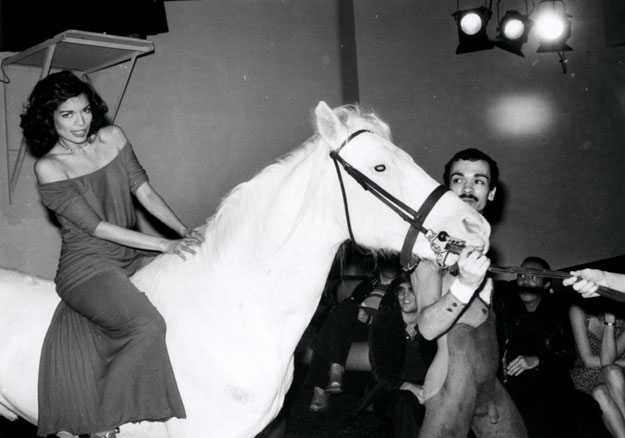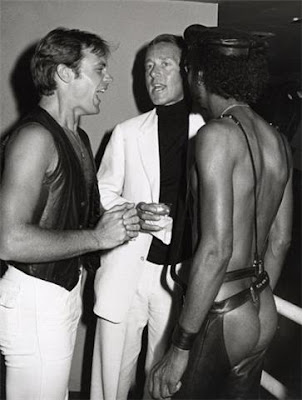 |
| Ticked Vip for "the Studio" |
A finales de los setenta una joven Nueva York comenzaba a experimentar la noche, mientras que la música disco comenzaba a abarrotar las salas. Lo que empezó siendo una especie de coliseo operístico, pasando por un local teatral y uno de los estudios de la cadena CBS, se convirtió, posiblemente, en una de las discotecas más míticas hasta ahora.
Un joven y emprendedor Steve Rubell, conoció a Ian Schrager mientras estudiaban en la universidad. Rubell, cuya intención era convertirse en dentista, acabó estudiando fianzas, hasta que años más tarde junto con Schrager abrieron un local en Queens. Fue Carmen D'Alessio, la relacionista pública de Valentino, quien animó a ambos a "dar el salto a Manhattan". Ella fue la introducción de Rubell y Schrager a la multitud de la jet-set.
Carmen D'Alessio contaba con valiosos contactos de Europa y América, y para la inauguración del local, remitió invitaciones por correo a 5.000 personas elegidas de sus listas de amigos y conocidos ilustres. A la inauguración acudieron Mick Jagger y su entonces pareja, Bianca, Salvador Dalí, Liza Minnelli, Donald Trump y su esposa Ivana, Debbie Harry, Brooke Shields y un largo etcétera. Varias estrellas como Warren Beatty, Cher, Woody Allen y Frank Sinatra querían disfrutar del festejo pero no pudieron entrar; se cuenta que varios de ellos fueron rechazados por el despótico control que se ejercía en la puerta.
Truman Capote era otro asiduo del local, como Al Pacino, Elizabeth Taylor, Andy Warhol, Grace Jones o Bette Davis. Era una auténtica oportunidad para poder entablar conversaciones con lo más cool de la época. La mezcla era perfecta y los espectáculos que Steve organizaba, no tenían precedentes. Para el cumpleaños de Bianca Jagger, Steve, le compró un caballo blanco enorme, para que hiciera la entrada en el local montada en él. No conocía límites porque nada estaba prohibido en su interior.
 |
| A memorable entry. |
Studio 54, fue conocido por el hedonismo que se producía dentro de ella; los balcones eran conocidos por los encuentros sexuales, y el uso de drogas era rampante. Su pista de baile estaba decorada con una pintura de un hombre en la Luna, que incluía una cuchara de cocaína. Tuvo un papel formativo en el crecimiento de la música disco y la cultura de los clubes nocturnos en general, y fue uno de los primeros en borrar la distinción entre vida nocturna homosexual y heterosexual.
¿Puedes imaginar un lugar así a dia de hoy? Muchas personas actuarían como si del fin del mundo se tratase...
( Can you imagine such a place today? Many people would act as if world ends it were... )
A Rubell, un personaje llamativo y abiertamente homosexual, se le conocía por seleccionar a su antojo a los clientes, eligiéndolos del gigantesco tumulto de gente que esperaba afuera. Rubell mezclaba hermosos "don nadies" con glamurosas celebridades en el mismo recinto, pues seguía la lógica de que los extremos o excesos son el camino a la perfección, o como decía: "El camino del exceso conduce al palacio de la sabiduría".
 |
| Andre Leon, Rubell and Andy Warhol. |
 |
| The gorgeus Farrah Fawcett moving the skeleton. |
En diciembre de 1978, Studio 54 sufrió una redada policial después de que Rubell dijera en una entrevista que solo la Mafía era más rentable que su negocio. Fueron acusados por fraude fiscal, tres años y medios de cárcel.
 |
| Steve Rubell, Michael Jackson, Steven Tyler and Cherrie Currie of the runaways at Studio 54. |
 |
| A very young Tom Cruise. |
La discoteca se cerró con una parte final denominada "El final de la Gomorra", el 4 de febrero de 1980. Diana Ross, Ryan O'Neal, Mariel Hemingway, Jocelyn Wildenstein, Richard Gere, Gia Carangi, Jack Nicholson, Reggie Jackson, y Sylvester Stallone se encontraban entre los invitados esa noche. Después de cerrar la discoteca, la cocaína y dinero fueron encontrados en sus paredes. Schrager y Rubell fueron declarados culpables y pasaron 13 meses en prisión.
 |
| Diana Ross |
Se cuenta que la última copa que se sirvió la bebió Stallone. Studio 54 fue un visionario concepto del ocio nocturno, donde el diseño, la escenografía y la decoración se convierten en protagonistas absolutos.
 |
| Liza Minneli and Michael Jackson among others. |
 |
| Stallone and Warhol. |
 | ||
| Woody Allen and Michael Jackson. |
 |
| Jerry Hall and Debbie Harry. |
 |
| Steve Rubell, a guy with people skill |
En 1985, después de descubrir que había contraído SIDA, Rubell (que había permanecido “en el armario” durante toda su vida) comenzó a tomar AZT, pero su enfermedad empeoró por el consumo continuado de alcohol y drogas lo cual afectó su ya comprometido sistema inmunológico. Rubell murió el 25 de julio de 1989 oficialmente a causa de hepatitis. Schrager siguió con los negocios, actualmente es un exitoso empresario hotelero.
Algunos de los singulares shows que se daban en aquel studio, con Grace Jones como estrella principal.
(Some of the rare shows that were at the studio with Grace Jones as star.)
Studio 54 marcó un antes y un después, era la sala de la libertad, estaba permitido hacer y consumir todo lo que se te cruzara por la cabeza, y posiblemente no haya vuelto a existir un lugar como aquel. Lo que empezó como una pequeña idea, acabó convirtiéndose en una leyenda...
 |
| The mythical moon of Studio 54. |
( In the late seventies a young New York began to experience the night, while the music disco began to cram the rooms. What began as a kind of operatic coliseum, through a local theater and one of the studios of CBS, it became possibly one of the most legendary clubs so far.
A young entrepreneur Steve Rubell, met Ian Scrager while they were studying at college. Rubell, who had the intention of becoming a dentist, ended up studying finance, and years later with Schrager opened a restaurant in Queens. Carmen D'Alessio, a Valentino public relations agent who had been throwing fashionable parties, encouraged Steve Rubell and Ian Schrager, who were operating in Queens, to make "the leap into Manhattan". She was to introduce Rubell and Schrager to the jet-set crowd.
Carmen D'Alessio had valuable contacts of Europe and America, and for the inauguration she forwarded email invitations to 5,000 people selected from their lists of friends and famous. The inauguration was attended by Mick Jagger and his then partner, Bianca, Salvador Dali, Liza Minnelli, Donald Trump and his wife Ivana, Debbie Harry, Brooke Shields and many more. Several stars like Warren Beatty, Cher, Frank Sinatra and Woody Allen wanted to enjoy the festivities but they couldn't get it, is counted that several of them were rejected by the despotic control being exerted on the door.
Truman Capote was another regular at the local, as Al Pacino, Elizabeth Taylor, Andy Warhol, Grace Jones and Bette Davis. It was a authentic opportunity to engage talks with the cool people of the time. The mixture was perfect and the shows that Steve organized, were unprecedented. For Bianca Jagger's birthday, Steve, bought her a huge white horse, to do local entry mounted on it. Knew no bounds because nothing was forbidden inside.
Studio 54 was notorious for the hedonism that occurred within it; the balconies were known for sexual encounters, and drug use was rampant. Its dance floor was decorated with a depiction of a Man in the Moon that included an animated cocaine spoon. It was a formative role in the growth of disco music and nightclub culture in general, and was one of the first to blur the distinction between gay and straight nightlife.
A Rubell, a striking and openly gay character, became widely known for hand-selecting guests from the always-huge crowds outside, mixing beautiful "nobodies" with glamorous celebrities in the same venue, because the logic was that the extremes or excesses are the way to perfection, as he said: "The road of excess leads to palace of wisdom."
In December 1978, Studio 54 was raided after Rubell was quoted as saying that only the Mafia made more money than the club brought in. they were sentenced to three and a half years in prison. Rubell and Schrager were charged for the tax evasion charge.
The nightclub closed with one final party called "The End of Modern-day Gomorrah", on February 4, 1980. Diana Ross, Ryan O'Neal, Mariel Hemingway, Jocelyn Wildenstein, Richard Gere, Gia Carangi, Jack Nicholson, Reggie Jackson, and Sylvester Stallone were among the guests that night. After the nightclub's closing, cocaine and money were found in its walls. Schrager and Rubell were found guilty and would spend 13 months in prison.
It's said that the last drink was served, Stallone drank it. Studio 54 was a visionary concept of nightlife, where the design, set design and decoration become protagonists.
In 1985, after discovering he had contracted AIDS, Rubell (who was closeted for most of his life) began taking AZT, but his illness was furthered by his continued drug usage and drinking, which affected his already compromised immune system. Rubell died on July 25, 1989, with the official cause of death listed as hepatitis. Schrager continued business, now is a successful hotelier.
Studio 54 marked a before and after, it was room of freedom, it was allowed to make and consume everything that came into my head; and possibly there hasn't returned to exist a place like that. What began as a small idea, eventually became a legend ...)













No hay comentarios:
Publicar un comentario